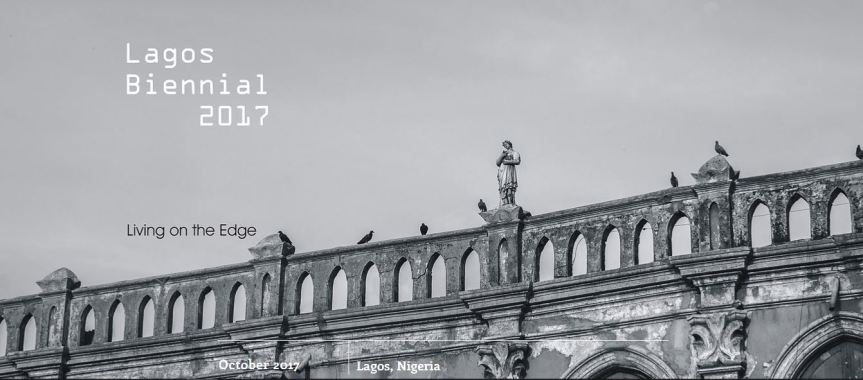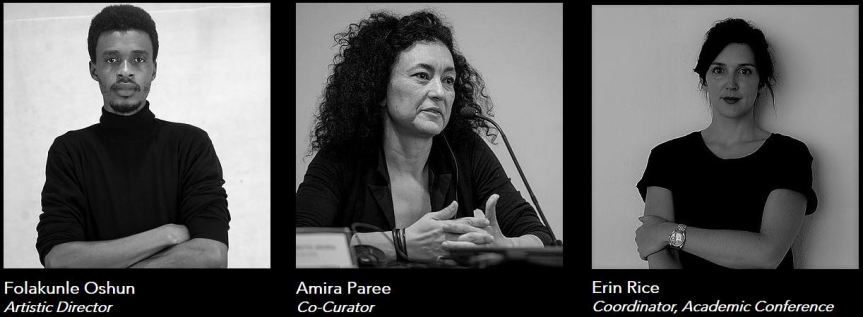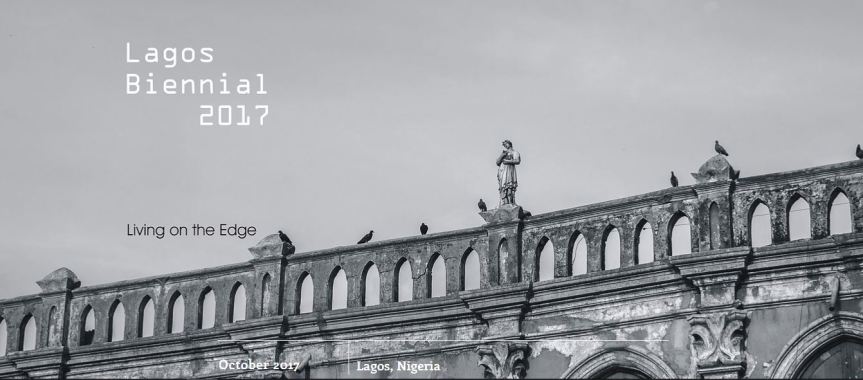Folakunle Oshun -Osh- is not an ordinary artist-curator. He has been working for some time on a truly ambitious project: organizing a city-wide art biennial in Lagos. Though, officially, he is just the Artistic Director, Osh is the soul and engine of the biennial. It is his idea and he is its main driver. He has Amira Paree as co-curator and Erin Rice is in charge of the Academic Conference that will be part of the biennial and will take place at the University of Lagos. The collective Perpetuum Mobile will provide curatorial support.
The Lagos Biennial 2017, comes as an exciting surprise soon after Tokini Peterside took another daring step and launched last year an art fair with an international character: ArtX Lagos. We have now in Lagos an art fair, an art biennial, an international Photo Festival, auctions houses, several new art galleries, an art museum under construction at Pan-Atlantic University, a couple of art foundations offering art residences, a well-funded art competition. Piece by piece, Lagos is developing the art infrastructure needed for a sustainable artworld.
 A couple of days ago, I had a long chat with Osh on the Biennial. I wanted to know about his plans, and his dreams…. There are already well over one hundred biennials spread all over the world. Why another one? What does he want to achieve? How is it going to be supported? What is its curatorial direction?. Where is it going to hold? Which artist will participate? He explained to me that the primary aim of this biennial is to open Lagos to the rest of the world as an art destination: “As a Lagosian I feel a sense of responsibility and ownership of this space and I’ve always wondered why it took this long for Lagos to have its own Biennial”.
A couple of days ago, I had a long chat with Osh on the Biennial. I wanted to know about his plans, and his dreams…. There are already well over one hundred biennials spread all over the world. Why another one? What does he want to achieve? How is it going to be supported? What is its curatorial direction?. Where is it going to hold? Which artist will participate? He explained to me that the primary aim of this biennial is to open Lagos to the rest of the world as an art destination: “As a Lagosian I feel a sense of responsibility and ownership of this space and I’ve always wondered why it took this long for Lagos to have its own Biennial”.
In recent years, Biennials and Art Fairs have sprung up all over the world. Though their scope and content increasingly overlap -and both of them aim at international representation and audiences- they tend to occupy different social, cultural and economic spaces. Art fairs focus mainly on the commercial side of art, while biennials tend to address issues and bring to the public a different kind of artistic concerns. Generally, art fairs work hand in hand with galleries and dealers, while biennials (Venice, Gwangju, Sao Paulo, Whitney (New York), Dak’art, Istanbul, La Habana…), are artist-led or have public institutions as their main partners. An important difference between art Fairs and biennials is the curatorial input they receive. Though both may have a general theme for the event, most art fairs will leave the selection of the artworks to each of the galleries or artists participating in the fair. On the contrary, the most important biennials have a heavy curatorial intervention at general level and at the pavilion or stand level. Every artist and artwork present at a biennial has, generally, been selected by a curator. For the Lagos Biennial 2017, Osh has taken the title of Mario Macilau’s project “Living on the edge” as the theme of the biennial. His goal is to catalogue the stories of artists all over the world living in and around crisis situations. With the Biennial, he wants to touch positively the lives of real people.
“We must accept that we are living in strange times. I hear a lot about the good old days, but I don’t know what I will tell my kids about these present times. The biennial serves as a sort of archive, like taking a portrait of the world: so I’m asking everyone to say cheese. Of course you don’t expect too many smiles, these are hard times. Nigeria itself is in a recession but as Fela noted “Suffering and smiling”. As a country we’ve learnt to shake of the dust and keep moving, gossip about the scandals and throw them under the rug. I think a lot of people will be shocked by the character of the biennial due to our curatorial approach. This is a biennial that could happen anywhere in the world, but in this peculiar case, Lagos is the canvas. You don’t even need to make art in Lagos, just go downtown of Idumota and breathe. It is the juxtapositions of these experiences brought by the invited artist (home and abroad) that really creates the magic.”
 While art fairs tend to be market-driven and display “collectable” (read, “saleable”) art, biennales are ready to present to the public more experimental works (read, “not easily saleable”). Painting and sculpture predominate in the nice booths of art fairs. Installations, performances, conceptual and video art occupy most of the spaces in biennales. It is not a surprise that Jelili Atiku will present a performance at the Biennial. For it, he has asked Osh to look for a “not easily accessible” place in Lagos… Osh intends to “work with the Local communities and investigate untold stories in the deepest crannies of the city. You can’t predict the outcome of that.” His target is to bring 40 artists from more than 20 countries. Over 30 of them have already confirmed their participation. Undoubtedly, the biennial is going to attract the attention of the global artworld to one of the most vibrant “peripheral hubs” in the global art map.
While art fairs tend to be market-driven and display “collectable” (read, “saleable”) art, biennales are ready to present to the public more experimental works (read, “not easily saleable”). Painting and sculpture predominate in the nice booths of art fairs. Installations, performances, conceptual and video art occupy most of the spaces in biennales. It is not a surprise that Jelili Atiku will present a performance at the Biennial. For it, he has asked Osh to look for a “not easily accessible” place in Lagos… Osh intends to “work with the Local communities and investigate untold stories in the deepest crannies of the city. You can’t predict the outcome of that.” His target is to bring 40 artists from more than 20 countries. Over 30 of them have already confirmed their participation. Undoubtedly, the biennial is going to attract the attention of the global artworld to one of the most vibrant “peripheral hubs” in the global art map.
All the major global art fairs: Art Basel (Basel & Miami), Frieze (London & New York), ARCO (Madrid), FIAC (Paris), etc. take place in a large single venue. Biennials are different. Most frequently, they are organized around multiple venues spread through the city. Tyoically, they are city-wide events put together by local or regional authorities with the aim of giving international visibility to a city. Many of the most prominent biennials are just one more component of the “edutainment” or cultural tourism industry and quite a few of them have succeeded in putting cities into the global cultural maps. The case of Gwuangju, in South Korea, is a good example of it.
When Venice Biennale was launched in 1895, it was very similar in format to a typical 19th century phenomenon that has endured till our days: the world art fair organized around national pavilions. The Lagos Biennial will not follow this format. There will not be National pavilions, but Osh has managed to convince a few foreign-based artists to come to Lagos. “These artists will be bringing their own experiences and stories and I think it will be fascinating to trace the tangent points where our stories overlap. The human experience is one; it’s pretty much the same everywhere you go. People are trying to survive and get ahead in life, but you see, the Lagos hustle is incomparable to anything. Even I cannot predict how things will turn out at the biennial due to the unpredictable nature of the city.”
I asked Osh whether the fact that the art fair (ArtX Lagos) and the biennial will take place at the same time will be problematic. He is not worried: “I think Art X complements the Biennial and vice versa, It is important for the public to begin to understand that art is big money and that’s what Art X brings to the table. The Lagos Biennial on the other hand opens up more room for artistic expression and dialogue.”
 The dates are already fixed (October 14 – December 22, 2017). Many aspects of the biennial are still undefined, but Osh is determined to succeed. Surely, we will not see the lavish extravaganza of Venice, the broad participation in Sao Paolo or the transformation of a city during the days of Dak’Art, but an art biennial, even if it has an ultra-low budget and not much of institutional support, can give a good push to the development of the Lagos artworld. I already look forward to the days in October when an art fair and a biennial run concurrently in Lagos. I missed ArtX last year. This time, I am going nowhere else during those days…
The dates are already fixed (October 14 – December 22, 2017). Many aspects of the biennial are still undefined, but Osh is determined to succeed. Surely, we will not see the lavish extravaganza of Venice, the broad participation in Sao Paolo or the transformation of a city during the days of Dak’Art, but an art biennial, even if it has an ultra-low budget and not much of institutional support, can give a good push to the development of the Lagos artworld. I already look forward to the days in October when an art fair and a biennial run concurrently in Lagos. I missed ArtX last year. This time, I am going nowhere else during those days…
Jess Castellote

